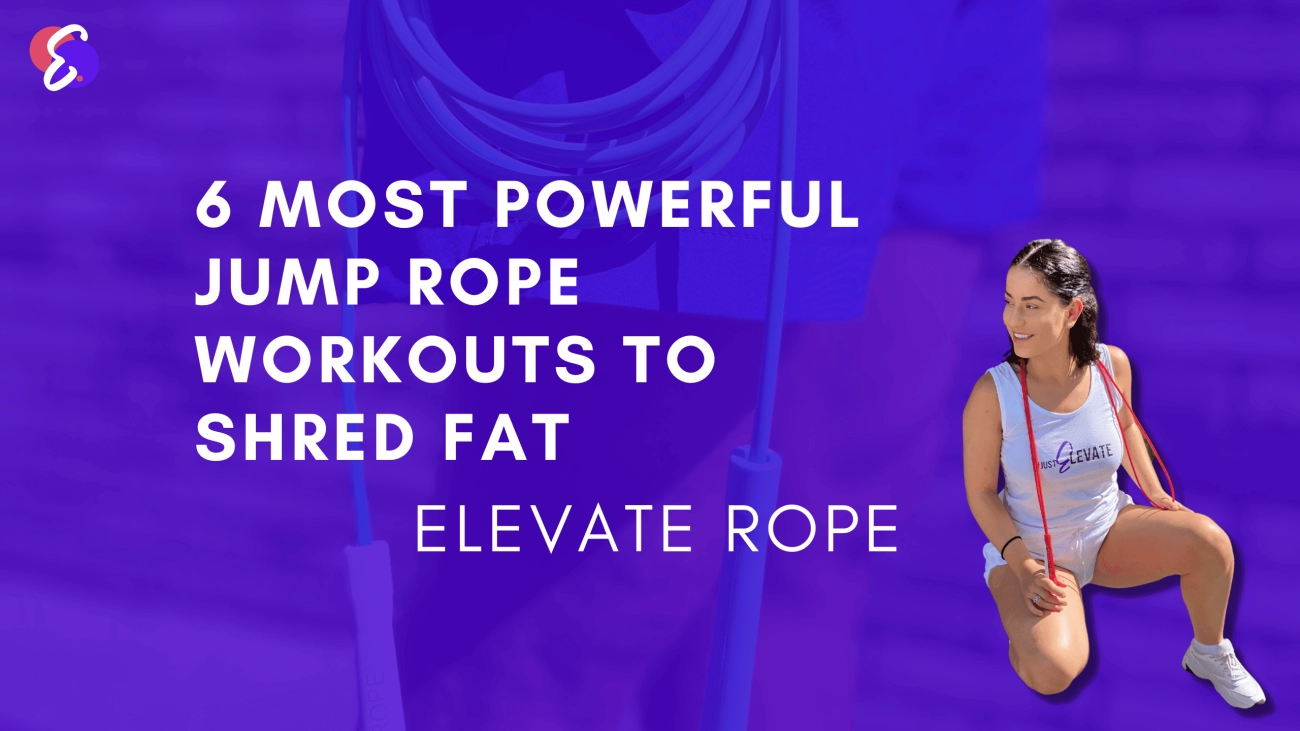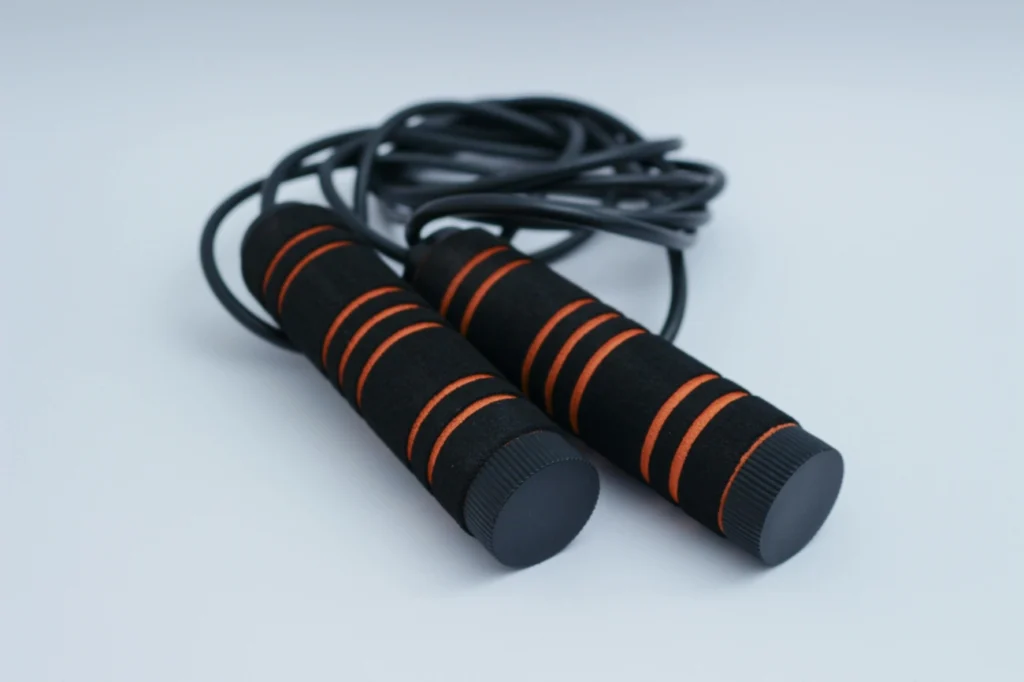Want to burn fat, boost endurance, and transform your fitness—all in just minutes a day?
Then it’s time you discovered Jump Rope HIIT.
This high-intensity interval training method combines the simplicity of a jump rope with the fat-burning power of short, explosive workouts. The result? Maximum calorie burn, improved agility, and enhanced cardiovascular health—without hours at the gym.
Whether you’re a beginner looking for a quick home workout or an athlete chasing peak conditioning, Jump Rope HIIT delivers fast, noticeable results. And if you want the best performance, using a quality jump rope from JumpRopeManufacturer can make all the difference.
Let’s dive in and find out how you can start your Jump Rope HIIT journey today.
What is Jump Rope HIIT
Jump Rope HIIT is a high intensity jump rope workout that combines jump rope training with the proven benefits of High-Intensity Interval Training (HIIT). It’s a simple yet powerful approach to fitness that blends short bursts of intense skipping with brief recovery periods, pushing your body to burn more calories in less time.
Definition of High Intensity Interval Training
HIIT is a workout method where you alternate between short, all-out efforts and low-intensity recovery. This style of training:
- Maximizes calorie burn in a shorter session
- Boosts metabolic rate for hours after the workout
- Improves endurance and cardiovascular strength faster than steady-paced cardio
Example:
| Phase | Duration | Effort Level |
|---|---|---|
| Sprint phase | 20 sec | 90-100% max effort |
| Rest phase | 10 sec | Low intensity or pause |
Role of Jump Rope in HIIT Workouts
Using a jump rope in HIIT brings unique benefits:
- Total body engagement – arms, shoulders, legs, and core work together
- Better coordination and agility through consistent rhythm
- Portable cardio tool — easy to use anywhere
- Fast calorie burn thanks to constant movement and high effort
Unlike other HIIT equipment, a jump rope is low-cost, requires minimal space, and offers instant workout intensity.
Traditional Cardio vs Jump Rope HIIT
| Feature | Traditional Cardio | Jump Rope HIIT |
|---|---|---|
| Intensity | Steady pace | Intense bursts with recovery |
| Time requirement | 30–60 minutes | 10–20 minutes |
| Calorie burn rate | Moderate | High in short time |
| Muscle engagement | Lower body focused (e.g., jogging) | Full body involvement |
| Afterburn effect | Minimal | Significant (EPOC – excess post-exercise oxygen consumption) |
Scientific Effectiveness of Jump Rope HIIT
Studies show that jump rope HIIT routines:
- Increase VO₂ max (cardio capacity) faster than steady-state training
- Burn up to 25-30% more calories in the same session length compared to jogging
- Trigger EPOC, keeping metabolism elevated for up to 24 hours
- Enhance fat oxidation, making it effective for body composition goals
For people seeking a fat burning jump rope workout, this method is one of the most efficient, combining cardiovascular conditioning, full-body strength, and high caloric output in minimal time.
Benefits of Jump Rope HIIT Workouts
Jump Rope HIIT isn’t just fun — it’s one of the most effective and portable full-body conditioning workouts you can do. Whether you’re training at home, at the gym, or outside, it delivers results fast.
Cardiovascular Improvements
High-intensity jump rope intervals push your heart rate into the aerobic and anaerobic zones, strengthening your heart and lungs. This helps improve endurance, circulation, and overall cardiovascular health, similar to running or cycling but with less workout time.
Fat Burning and Weight Loss
Because Jump Rope HIIT keeps your heart rate elevated while engaging multiple muscle groups, you burn more calories in less time compared to steady-state cardio. The afterburn effect (EPOC) means you keep burning calories even after you’re done.
Average Calorie Burn per 30 Minutes (varies by intensity and weight):
| Fitness Level | Calories Burned* |
|---|---|
| Beginner | 300–400 |
| Intermediate | 450–550 |
| Advanced | 600+ |
*Estimates based on a 155–185 lb person
Improved Coordination and Agility
Jump rope movements challenge timing, balance, and rhythm, which sharpens coordination. This also translates into quicker footwork and better body control — skills athletes rely on in sports and everyday movement.
Time Efficiency
A 10–20 minute jump rope HIIT can burn as many calories as a 30–40 minute jog. Short bursts of all-out effort followed by rest allow you to build cardiovascular endurance, burn fat, and tone muscles in minimal time.
Example:
- 30 seconds of high knees with a rope
- 15 seconds rest
- Repeat for 10–15 minutes
Mental Focus and Endurance
The rhythm of jump rope combined with HIIT pacing builds mental discipline and concentration. You need focus to maintain form under fatigue, which trains your mind along with your muscles.
Low Cost and Portable
A good jump rope costs far less than most gym equipment, takes up no space, and fits in your bag. It’s a travel-friendly workout solution — perfect for home, office breaks, or outdoor training.
How to Perform Jump Rope HIIT Workouts Step by Step
Warm Up for Jump Rope HIIT
Before you start an intense jump rope HIIT routine, warming up is non‑negotiable. It protects your joints, gets blood flowing, and preps your muscles for explosive movement.
Quick warm‑up ideas:
- 2–3 minutes light skipping at an easy pace
- Bodyweight mobility drills: arm circles, ankle rolls, hip rotations
- Dynamic stretches: walking lunges, high knees, butt kicks
Types of Jump Rope HIIT Exercises
Mixing up your moves keeps your workout challenging and hits different muscle groups:
- Basic Jumps – The standard bounce, steady and rhythmic
- Double Unders – Rope passes under your feet twice per jump; higher intensity
- Criss-Cross – Cross arms in front mid‑jump; improves coordination
- High Knees – Drive knees above waist level; extra cardio burn
Sample Beginner Jump Rope HIIT Plan
Recommended ratio – 20 seconds of jump rope work / 40 seconds rest
| Round | Exercise | Work Time | Rest Time |
|---|---|---|---|
| 1 | Basic Jump | 0:20 | 0:40 |
| 2 | High Knees | 0:20 | 0:40 |
| 3 | Basic Jump | 0:20 | 0:40 |
| 4 | Criss-Cross | 0:20 | 0:40 |
Total time: 8–10 minutes including warm‑up and cool‑down
Progression for Intermediate to Advanced
Once your endurance improves, you can reduce rest time or add more challenging moves:
- 1:1 ratio – 30s work / 30s rest
- Double unders + high knees mix for explosive cardio
- Add weighted ropes from JumpRopeManufacturer for more resistance
- Increase rounds or add pyramid-style intervals
Cool Down and Stretching
A proper cool‑down helps with recovery and reduces soreness:
- Light skip or march in place for 1–2 minutes to bring heart rate down
- Static stretches: hamstrings, quads, calves, shoulders, wrists
- Deep breathing to relax muscles and restore oxygen flow
Pro tip: Always land softly on the balls of your feet to protect knees and ankles, especially during high-intensity jump rope cardio workouts.
Tips for Maximizing Your Jump Rope HIIT Performance
Use Proper Jump Rope Technique to Avoid Injury
Good form is non-negotiable for high-intensity jump rope workouts. Keep your elbows close to your body, wrists doing most of the turning, and shoulders relaxed. Land softly on the balls of your feet to reduce joint stress. Avoid jumping too high—keep it low and controlled to save energy and protect your knees and ankles.
Key reminders:
- Stay light on your feet.
- Keep your core engaged for stability.
- Maintain a steady rhythm—don’t rush the rope.
Choose the Right Jump Rope Length and Weight
A rope that’s too long drags, while a short one makes tripping more likely. Stand on the middle of the rope—handles should reach roughly to your armpits. For HIIT, speed ropes work best for quick bursts, while weighted ropes can increase intensity and build upper-body endurance. Adjustable ropes are ideal if you’re sharing with others or want to fine-tune your performance.
Maintain Form Under Fatigue
HIIT will push you hard, and sloppy form shows up fast when tired. Focus on:
- Staying upright—don’t hunch your shoulders.
- Landing evenly to avoid loading one leg more than the other.
- Keeping your wrists doing the turning, even when fatigue sets in.
When your form starts to break down, shorten your sets or slightly decrease speed to keep it clean.
Master Breathing Techniques During HIIT
Efficient breathing keeps your heart rate stable and helps you push longer. Breathe in through your nose for quick recovery during rest intervals, and out through your mouth during intense bursts. Avoid holding your breath—it spikes fatigue faster. Pair your breathing rhythm with your jumps so oxygen flow stays consistent.
Respect Rest and Recovery Between Intervals
Rest periods in jump rope interval training plans aren’t wasted time—they’re there to help you sustain high output. For beginners, start with a 1:2 work-to-rest ratio (e.g., 20 seconds jumping, 40 seconds rest). Intermediate and advanced jumpers can shorten rest periods as endurance improves. Between HIIT sessions, allow at least 24–48 hours for recovery to reduce injury risk and boost long-term progress.
Choosing the Perfect Jump Rope for HIIT from JumpRopeManufacturer
When it comes to jump rope HIIT workouts, the type of rope you use can make or break your performance. At JumpRopeManufacturer, we design ropes that fit the demands of serious HIIT training — focusing on speed, durability, and comfort.
Types of Jump Ropes for HIIT
Not every rope works the same. Here are the most popular options we provide for different fitness goals:
- Speed Ropes – Lightweight, fast rotation for quick intervals, perfect for high-intensity jump rope workouts and double unders.
- Weighted Ropes – Add resistance for muscle engagement and calorie burn, ideal for fat-burning jump rope workouts.
- Cordless Ropes – Handles with short weighted cords for tight spaces or low-impact training, great for apartment workouts.
How Our Jump Ropes Boost HIIT Efficiency
Our ropes are built for smooth rotation and consistent speed, cutting down wasted effort so you can keep your focus on maintaining intensity. Whether it’s a rapid 20-second sprint set or a full conditioning round, the right rope means less drag, more control, and better endurance.
Why Durability, Adjustability, and Grip Matter
For HIIT, your rope needs to handle constant use and quick transitions without wearing out. That’s why our ropes feature:
- Durable materials – PVC-coated cables, UV-resistant beaded ropes for long life.
- Adjustable length – A perfect fit boosts efficiency and reduces the risk of tripping.
- Ergonomic grip – Non-slip handles keep you in control, even when sweating through intense rounds.
What Customers Are Saying
- “The speed rope from JumpRopeManufacturer took my HIIT from okay to intense. Smooth spin, no tangles.” – Mark R., Texas
- “Love the adjustability. I set it up for my height in seconds. Best jump rope for HIIT I’ve used.” – Jenna L., California
- “Weighted rope is a game-changer for fat loss. Feels solid and built to last.” – Chris B., Florida
With the right jump rope in hand, your HIIT sessions can be faster, smoother, and more effective — no wasted movement, just results.
Sample Jump Rope HIIT Workout Plans for Different Fitness Levels
Here are ready-to-follow jump rope HIIT routines you can do at home, at the gym, or on the go. Each plan is built to suit a specific fitness level, but you can adjust the intervals to match your ability and goals.
Beginner Jump Rope HIIT 10 Minute Routine
Perfect if you’re new to HIIT or getting back into cardio. Focus on basic jumps to build endurance and coordination.
| Time | Exercise | Effort Level |
|---|---|---|
| 0:00 – 1:00 | Basic jump | Easy warm-up pace |
| 1:00 – 1:30 | Basic jump | Moderate |
| 1:30 – 2:00 | Rest | — |
| 2:00 – 2:30 | High knees | Moderate |
| 2:30 – 3:00 | Rest | — |
| Repeat for 4 more cycles | Alternate basic jump and high knees | — |
| Final minute | Basic jump | Cool-down pace |
Tip: Keep jumps low to reduce impact and avoid burning out too soon.
Intermediate Jump Rope HIIT 20 Minute Fat-Burning Session
For those who are comfortable with basic jumps and want to burn fat faster.
| Time | Exercise | Effort Level |
|---|---|---|
| 0:00 – 2:00 | Basic jump | Warm-up pace |
| 2:00 – 2:30 | Double unders | High intensity |
| 2:30 – 3:00 | Rest | — |
| 3:00 – 3:30 | Side-to-side jumps | High intensity |
| 3:30 – 4:00 | Rest | — |
| Repeat sequence for 6 more rounds | — | — |
| 18:00 – 20:00 | Basic jump | Cool-down pace |
Tip: Try to keep rest periods active by walking in place or slow jumping to maintain heart rate.
Advanced Endurance and Speed Challenge
Ideal for experienced jumpers looking to push stamina, speed, and agility.
| Time | Exercise | Effort Level |
|---|---|---|
| 0:00 – 2:00 | Basic jump | Warm-up pace |
| 2:00 – 2:20 | Double unders | Max effort |
| 2:20 – 2:40 | Criss-cross | Moderate |
| 2:40 – 3:00 | Rest | — |
| Repeat 8 cycles | — | — |
| Final 2 minutes | High knees | Sprint pace |
Tip: Choose a speed rope with a comfortable grip to handle fast rotations.
Customizing Jump Rope HIIT Intervals for Your Goals
- For fat loss: Short bursts (20–30 sec) at high intensity with equal or slightly longer rest (30–40 sec).
- For conditioning: Medium bursts (40–60 sec) with shorter rest (15–30 sec).
- For stamina: Long sets (60–90 sec) at moderate pace with minimal rest (10–20 sec).
Pro move: Track your rounds and try to increase reps or reduce rest gradually to keep progressing.
Frequently Asked Questions about Jump Rope HIIT
Can Jump Rope HIIT help with weight loss
Yes. Jump Rope HIIT is one of the most effective fat-burning workouts you can do in a short amount of time. The mix of high-intensity intervals and short rest periods spikes your heart rate, increases calorie burn during and after the workout (known as the afterburn effect), and helps preserve muscle while burning fat. Combine it with a balanced diet, and you can expect noticeable results in fat loss and overall fitness.
How often should I do Jump Rope HIIT workouts
For most people, 2–4 sessions per week is enough. HIIT is intense, so your body needs recovery time between workouts to avoid overtraining and injury. Beginners may want to start with 10–15 minutes, twice a week, and increase frequency slowly as endurance improves.
Is Jump Rope HIIT safe for beginners
It can be, if you start slow and use proper form. Beginners should:
- Use a light rope to reduce joint stress.
- Start with low-intensity intervals (example: 20 seconds jumping, 40 seconds rest).
- Focus on basic single jumps before trying moves like double unders or criss-cross.
- Wear supportive shoes and jump on a softer surface like a gym mat or wooden floor.
What to do if you experience shin splints or joint pain
Shin splints and joint pain often happen when you do too much, too soon or jump on hard surfaces. To avoid or fix the problem:
- Reduce jump frequency until pain subsides.
- Switch to a softer surface.
- Check your rope length and jumping form (stay on the balls of your feet with small jumps).
- Add stretching and calf-strengthening exercises to your routine.
- If pain persists, take a break and see a sports medicine professional.
How to track progress in Jump Rope HIIT training
Tracking progress keeps you motivated and helps fine-tune your workouts. You can:
- Count jumps per interval and try to increase over time.
- Use a fitness tracker to monitor heart rate, calories burned, and recovery.
- Record your workout times, rest ratios, and new skills learned.
- Measure improvements in stamina — for example, less fatigue at the same intensity.



